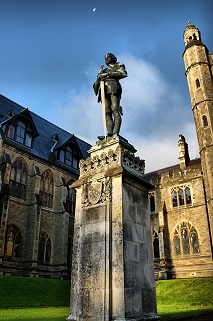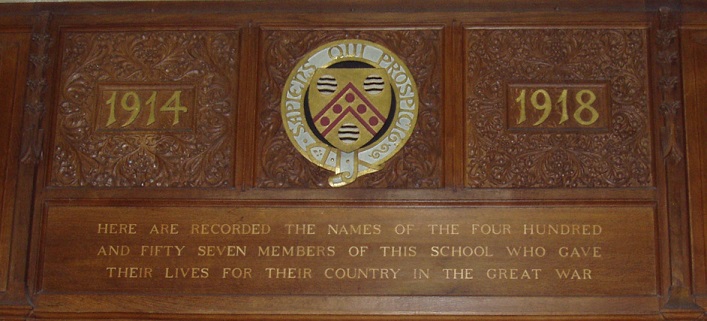



The following is a list with biographies of the 462 people who attended Malvern College and died due to the First World War. Altogether 2,833 are known to have served. There is also a corresponding page commemorating the 249 casualties in the Second World War.
There was not a month from August 1914 to November 1918 that an Old Malvernian did not become a casualty, with 6 killed on the first day of the Battle of Loos on the 25th September 1915 and 13 killed on the first day of the Battle of the Somme on the 1st July 1916.
The vast majority of casualties occurred in France and Belgium with 31 names recorded on the Menin Gate at Ypres, and 23 at Thiepval. There were also 23 casualties in Turkey due to the Gallipoli Campaign, and 16 in Iraq, including 2 near Kut.
They were in a wide range of regiments including 26 in the Royal Field Artillery, 13 in the Royal Engineers, 12 in the Worcestershire Regt, 11 in the Canadian Inf, 11 in the East Kent Regt (The Buffs), and 5 in the Royal Flying Corps and the Royal Air Force.
Most were officers with 133 Captains, 126 2nd Lieutenants, 114 Lieutenants, 26 Majors, and 15 Lieutenant Colonels.
29 received the MC, 10 the DSO and 1 the DCM, as well as 3 knighthoods (the CB, CMG, and MVO).
The information below is based primarily on the memorial books held at Malvern College which Ian Quickfall, and now Paul Godsland, the Malvernian Society archivists, have arranged to be digitised with the official memorial web site still in development.
Further information was also obtained from 'The Malvern College Register 1865-1924' edited by H.G.C Salmon, 'The Malvernian' school magazine, 'A History of Malvern College 1865 to 1965' by Ralph Blumenau, and 'Malvern College: A 150th Anniversary Portrait' by Roy Allen.
Information was also obtained from the Commonwealth War Graves Commission website, the Unit War Diaries and Service Records held at the National Archives in Kew, and various online commemorative websites whose links have been provided.
The main battles have tried to be identified in which Old Malvernians died in. Many though were killed in the general attrition of Trench Warfare which is so vividly described in the book 'Nothing of Importance' by Bernard Adams.
Below is a map showing the locations of the 246 cemeteries where Old Malvernians are buried or commemorated in. The markers are coloured yellow for one casualty, orange for between 2 and 9, and red for 10 or more. The name of the cemetery and number of casualties can be seen by hovering over the marker, and the list of names seen by clicking on the marker. Their full biographies and pictures can be seen by clicking on 'Further Info'.
The records can be filtered and/or sorted by name, house, age, regiment, battle, date, place etc by clicking on the appropriate drop down box and then the 'Search' button below the map. The original memorial book entry can be seen by clicking on the person's picture.
Son of A. P. Wood, Whitefold, Hale. Cheshire, b. 1899.
Middle IV A—Lower Modern II.
Afterwards at Bowdon College; R.M.C. Sandhurst; Lancashire Fusiliers 1918.
'During the all too short period he was a member of the School, he won the affection of many in the House. He left School long before his time, owing to illness, and his departure was regretted by all. He was a boy of distinct promise, and his early end on the battle-field, fighting for his country, cut short the life of one who had more than an ordinary future before him. He had only been a few days at the front when he met his death while leading his platoon over the top at dawn on November 1st. His commanding officer wrote of him as being a most promising officer, possessed of great personal bravery.' (Malvernian, Feb 1919).
Born: May 28th 1898, Hither Green. Son of Herbert A. J. Brouncker (Insurance Broker) and Alice Mabel Brouncker, of The Elms, Parkside, Eltham, London and 19 Parkside, Eltham.
Lower IV—Shell.
Great War (overseas), Private London Scottish; 2nd Lieutenant R.A.F. 211th Sqdn. Royal Air Force.
'Notwithstanding his diminutive stature, he was a boy of much grit and determination. He obtained a commission in the Flying Corps, and was out on duty, acting as Pilot Officer, on November 4th, 1918, since when nothing has been heard of him.' (Malvernian, Dec 1919).
Service record:WO 339/124287
Son of H. Stott, Inglewood, Queen's Road, Oldham, b. 1899.
Modern II—VI. Chance Prize. Hansell German. House Prefect.
Great War, R.F.C.; 2nd Lieutenant 6th West Riding Regt.
'George Stott from the first, though not destined for the army, was impatient to be serving. His service at the Front was short, only a few months; but sufficiently long to show that he was a gallant officer, and a fearless leader. It was while leading his men in the open on Nov. 5th that he was struck by shell splinters. His case was hopeless, and he died at Rouen Military Hospital three days later. Head of Modern Side, winner of the Chance and Hansell prizes, he promised to have a successful career. His sound common sense, and his ability to arrive at sane conclusions caused him to be regarded as a boy whose opinion was worth having. His good nature and instinctive kindliness invited friendships, and these he had in abundance.' (Malvernian, Feb 1919).